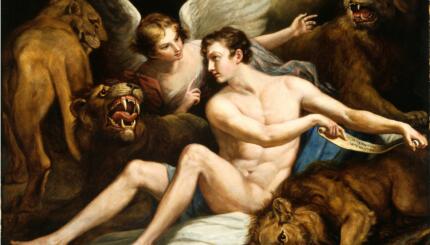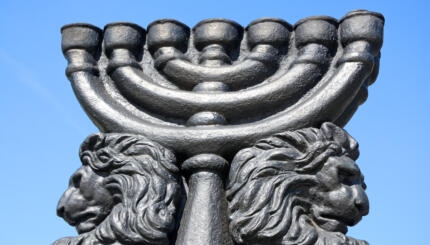According to Martin Luther‘s 1543 essay “On the Jews and Their Lies,” Jews demonstrate their “bloodthirsty” and “vengeful” character in their love of the Book of Esther. Luther, a priest who initiated the Protestant Reformation and a known opponent of Jews and Judaism, also said the Book of Esther should be ignored for being “too Jewish” and packed with “too much heathen corruption.” The 18th century German Bible scholar Johann David Michaelis took Luther’s attack on Mordecai and Esther one step further, by protesting Haman’s execution without a fair trial.
Luther and Michaelis were not the only ones to think that the Persian Jews in the Book of Esther should have turned the other cheek to Haman.

Michelangelo’s “The Punishment of Haman”
In Michelangelo’s depiction in the Sistine Chapel, “The Punishment of Haman” pays Haman the theological compliment of crucifying him. Though the Jewish (and literal) reading of the Book of Esther is that Haman is the evil antagonist, Michelangelo seems to imply the opposite: Haman’s attempt to kill the Jews was justified, and the fact that the Jews persecuted and killed Haman makes him like Jesus.
Haman’s Cross to Bear
Similarly, a miniature in the collection of The Hague, from around the year 1430, shows a bejeweled Esther kneeling before Ahasuerus begging for the lives of her fellow Jews. Ahasuerus, flanked by attendants and a bearded man, who might be Mordecai, extends his golden scepter to Esther. The story progresses from the left, where Esther kneels, to her right, where a near-naked Haman is crucified behind the seated scribe.

Help us keep Jewish knowledge accessible to millions of people around the world.
Your donation to My Jewish Learning fuels endless journeys of Jewish discovery. With your help, My Jewish Learning can continue to provide nonstop opportunities for learning, connection and growth.
The artist or artists who created the work, referred to as the Azor master, would have been familiar with the fourth century Vulgate, Jerome’s Latin translation of the Hebrew scriptures, which used the word crux to refer to the gallows which Haman created for Mordecai, and which Haman was later hanged upon.
The word the Hebrew Bible uses for the gallows, etz, more properly refers to a tree, though Hebrew versions of the Gospel of Matthew (controversial in their own right because there are no surviving versions from Matthew’s lifetime) also use the word etz in reference to Jesus’ crucifixion.
Jerome’s translation may have derived from the reference to Haman’s crucifixion in the Septuagint, which originated a few centuries earlier–initially by rabbis, who were forced to produce the translation, and later retranslated over time by Christian scholars. In addition, the first century Jewish historian Josephus‘ account of the story has Haman prepare a cross for Mordecai, and in Josephus’ version Haman’s death is by crucifixion. The fourth century monk Evagrius, who lived in Constantinople, implied in his writings that Jews of his time considered Haman’s death a crucifixion.
A number of medieval Christian authorities were certain that Jews acted upon the belief that Haman, like Jesus, was crucified. For example, the early fifth-century Theodosian Codex, a set of Roman laws, insisted that Jews abstain from “celebrating a certain feast” during which they “very shrewdly” showed their “secret hatred of the crucified Savior” by representing their enemy Haman as a crucified man and burning his effigy amidst “great shouting and frenzy just as if he were Christ.”
There are no other sources that clarify how widespread this practice was–or if it happened at all. But according to this source, fifth-century Jews drew comparisons between Jesus’ crucifixion on the second day of Passover and Haman’s hanging, which according to the occurred on the same day.
A Tale of Two Trees
Michelangelo and the Azor master are examples of Christian artists who appropriated an image from the Hebrew Bible and made it appear Christian, and in so doing subverted the Purim story, turning the Jews into the adversaries and making Haman the martyred hero. Interestingly, historian Katrin Kogman-Appel has identified two instances where Jewish artists or patrons drew upon Christian motifs in their illustrations of Haman.
In a 1272 mahzor by the artist Shemaya Hatsarfati (Shemaya the French), Haman and his 10 sons are depicted hanging from a tree, and the tree branches encircle each man and place him in a compartment. This motif resembles the Tree of Jesse, a Christian symbol intended to trace Jesus’ lineage back to the House of David and thus establish him as the messiah. The motif is like a family tree, demonstrating the generations between Jesse and Jesus. In Shemaya’s mahzor, the illustration of the Purim story appears on a page containing piyyutim, holiday-based poetic prayers, recited on Purim.
In the Dresden-Wroclav mahzor (pre-1293), Haman and his sons hang on a tree that more closely resembles the Christian motif of the Tree of Life, which places Jesus in the branches, flanked below by musicians, angels, and clerics.
According to Kogman-Appel, Jewish artists consciously appropriated Christian symbols, and assigned them new and “daring” Jewish meanings. In their rendering of the Christian symbols, the Jewish manuscript artists made the case that the cross was the symbol of Jewish persecution–not salvation, as Christian artists viewed it. For these artists, Haman’s death represented the Jewish triumph over the anti-Semitism of the cross-tree.
Haman and Amalek
In the figure of Haman swinging from the gallows or nailed to the cross, Jewish and Christian artists advanced their own religious agendas.
Jewish artists’ appropriation of the Christian motifs of the Tree of Life and the Tree of Jesse, and the alleged Jewish abuse of crucified effigies of Haman during Purim celebrations, suggests that Jews might have seen Haman as a sort of voodoo doll upon which they could take out their frustrations against contemporary Christians. Jews could also simultaneously project Haman’s Amalekite ancestry–and the eternal command to blot out Amalek–onto their Christian neighbors.
Christians seem to have been aware of the fact that for Jews Haman was a stand-in for Jesus, and this led Christian rulers to ban the practice of vandalizing Haman. Christian artists might have launched a more nuanced artistic program of defending Haman in the hopes of breaking the Jewish comparison between Haman and Jesus.
The Christian artists also might have had a more sinister aim. If they could convince the public who viewed their illustrations that Haman was crucified by the Jews, they would have found a historical and biblical precedent, before the birth of Christ, for crucifixion as a Jewish method of execution. In so doing, they would have lent much more credibility to the New Testament claim, which became the source of so much anti-Semitism in future generations, that the Jews pressured Pilate into crucifying Jesus.



